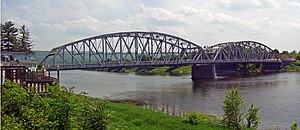Mid-Delaware Bridge
| Mid-Delaware Bridge | |
|---|---|

Bridge seen from Port Jervis side, upriver
|
|
| Coordinates | 41°22′18″N 74°41′52″W / 41.37167°N 74.69778°WCoordinates: 41°22′18″N 74°41′52″W / 41.37167°N 74.69778°W |
| Carries | Two lanes of |
| Crosses | Delaware River |
| Locale | Port Jervis, New York-Matamoras, Pennsylvania, United States |
| Maintained by | Joint Interstate Bridge Commission |
| Characteristics | |
| Design | Continuous steel truss |
| Total length | 659 feet (201 m) |
| Width | 44 feet (13.4 m) |
| Clearance below | 25 feet (7.6 m) |
| History | |
| Construction end | 1939 |
The Mid-Delaware Bridge, sometimes known as the Port Jervis-Matamoras Bridge or the Fourth Barrett Bridge, is a continuous truss bridge which carries U.S. Routes 6 and 209 across that river between those two communities and thus the states of New York and Pennsylvania. It is the only four-lane bridge on the upper main stem of the Delaware.
The current bridge, built by R.C. Ritz Construction Company in 1939 at a cost of $380,000, is the most recent in a long history of crossings between the two communities. It began in the mid-19th century, when the local Milford and Matamoras Railroad settled a dispute with the larger, growing Erie Railroad with the latter's assent to a law requiring that it construct a bridge across the Delaware at Matamoras that could carry both road and rail traffic. It was supposed to have been completed by 1852, but due to the railroad's unsuccessful efforts to have the law requiring the bridge declared unconstitutional it only began building it that year. It was finished in 1854.
In 1870 that bridge was destroyed in a storm. Directors of the Milford and Matamoras confronted Jay Gould about this in New York when the Erie showed no apparent interest in immediately rebuilding it. He told them the railroad had sold its interest in the bridge to another company, which turned out to be a dummy corporation. A new railroad bridge was built upstream
Port Jervis businessmen led by Charles St. John frustrated by the delays formed the Barrett Bridge Company to build a suspension bridge designed by John A. Roebling. The bridge which had two spans of 325 feet (99 m) opened in 1872. In March 1875 an ice dam on the Delaware upstream broke and in the ensuing flood, it took out the newly built railroad bridge above the Barrett Bridge. The rail bridge then took out sections of the Barrett Bridge which floated 25 miles (40 km) downstream but were relatively undamaged. They were carted back and reassembled within a few weeks.
...
Wikipedia
